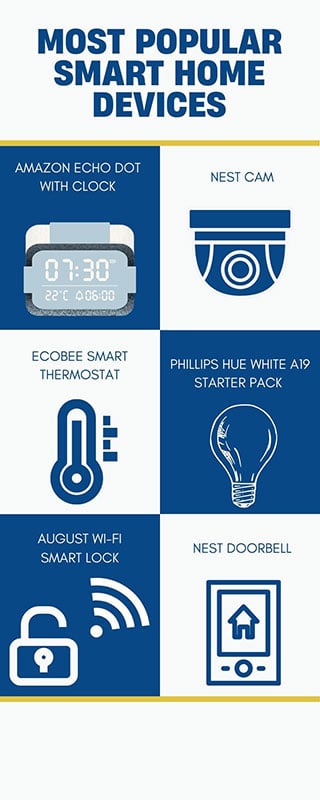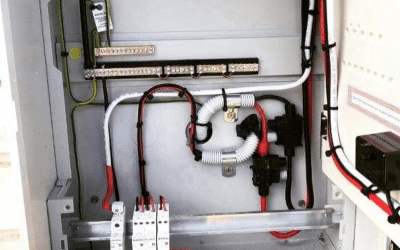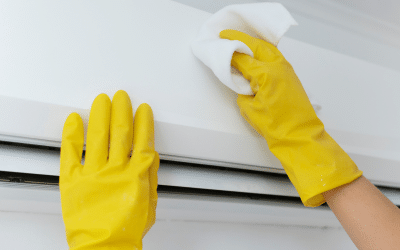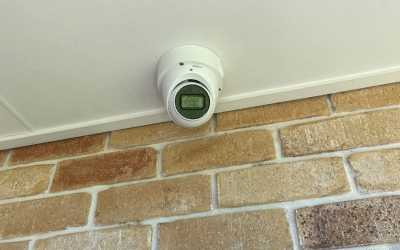We researched and collected smart home data specifically highlighting Australian statistics, analysed future trends, and discovered what qualifies as a smart home and who’s using smart devices within their homes amongst various other aspects.
Featured Statistics by order:
- Revenue in the Smart Home market is projected to reach US$3.24bn in 2022 (Statista)
- This year the global smart home market is valued at US$71.629 billion but is expected to have an annual growth rate of 20.7% until 2023 (Statista)
- The number of active smart households is expected to amount to 7.8m users by 2026 (Statista)
- 48% of boomers and seniors already own one or more smart home devices (Eco Voice)
- 13% do not take any action to secure their devices (Eco Voice)
- Only 14% of seniors 65+ feel they do not need or want to invest in IoT (Eco Voice)
- 40.8% of smart homes have at least one device vulnerable to cyber attacks that put the whole home in danger (Comfy Living)
- 41.7% of surveyed 25-34 year olds were concerned about security (Budget Direct)
- Almost three quarters 72.6% of smart home products and technology in
- Australia is bought by men, while women comprise just 27.4% of the buyers (Statista)
- Smart heating and cooling systems can save home users 50% in energy use (Comfy Living)
- Some insurance companies will reduce premiums by almost 20% for homes that have home automated security systems installed (Comfy Living)
An Introduction to Smart Homes
Smart home is a term that you should expect to hear more often as we head into the future of technology and as this growth industry soars in the next couple of years. The smart home sector was set to reach US$3.24bn this year just in Australia alone and globally set to be valued at a whopping US$71.629 and expected to have an annual growth rate of 20.7% until 2023.
So it’s safe to say that the smart home industry has started out with a bang. The smart home market in Australia is set to steadily grow over the four years and by 2026 we are estimated to have 7.8 million active smart households. So by now, the question on everyone’s mind is, what is a smart home? Since when did homes become smart? Well, there are certain qualifications that have to be met before a home becomes ‘smart’.
For a home to qualify as a smart home it must have a smart security feature or smart temperature (air-conditioning) as well as at least two smart features which include appliances, entertainment, lighting, outdoor sensors, and safety detectors. Smart home appliances can include quite a range of items including Amazon Alexa, Google Home, Smart Home Surveillance Cameras, Security Lock & Home Security Systems, Smart heating and cooling, Smart lighting, Smart kitchen appliances, Smart vacuums, Smart health & fitness devices, and smart outdoor gadgets.
Let’s look at some stats:
The ages of 24-34 and 45-54 dominated the smart home sector being the top smart home technology users. 48% of boomers and seniors already own one or more smart home devices while 14% of seniors (65+) feel as though they do not need any IoT (Internet of Things) appliances.
However, 13% of these people do not take any action when it comes to securing their devices, hence 40.8% of smart homes having at least one device vulnerable to cyber attacks that put the whole home in danger. Ironically, across all of the research, the number one motivator for installing the smart home technology was to enhance security.

Smart security systems, smart locks, video doorbells and cameras were the top purchases in the smart device sector and in a survey completed by Savvy it was found that increased safety and security was the key for adopting domestic smart home technology. Further assisted by a survey established by Budget Direct who claim 41.7% of the applicants they surveyed were concerned about security especially in the ages of 24-34 year olds.
Interestingly, across all statistics that were analysed we found that males dominated the smart home and smart device sector with almost three quarters of smart home products and technology being bought by men (72.6%), while women only hold 27.4% of the tech industry.
The benefits of having a smart home
Of course, having a smart home comes with its benefits, by slowly adding each smart home element to your house you are building a value that is greater than just your bricks and mortar.
After finding that the key motivator for adopting a smart home was to increase safety and security we can say that smart security cameras and surveillance systems would be a huge benefit to homeowners wanting to establish a smart home. We also found that some insurance companies can even reduce premiums by 20% for homes that have smart security systems.
Smart home devices give you the opportunity to control your home from the convenience of your mobile phone and from your location wherever that may be. Smart homes give you the time to take home management to the next level. By controlling everything from the one spot you can manage your household more efficiently, which lets be honest, is something that we try to do however most of the time we are unsuccessful.
By installing smart home devices such as smart heating and cooling systems you may be able to save up to 50% in energy use, not only benefiting your bills but reducing what is going into the environment. This also includes lighting systems within a smart home. Smart home gadgets are beneficial in adding to your property as it can add to a home’s resale value.
Potential home buyers are looking to buy homes that are already installed with smart home technology, research shows that they prefer a home that already has smart thermostats, fans, and lighting systems. It is also more economical to install smart wiring infrastructure when going through the building process, as it is easier to install before plastering and painting the home.
By implementing this whilst building a home it gives the homeowner a choice of whether they want to use the home automation system now or in the future. Whether or not they use it currently won’t matter, as long as it is installed it creates value and future opportunity.
The 10 most popular smart home devices on the market
Coming in at number 1 we have the Amazon echo dot with the clock. This smart home device acts as a clock, it can show the temperature as well as an installed timer and of course, includes the smart system, Alexa.
A small but effective smart home device. Number 2 calls for home safety with the Nest Cam. The Nest Cam is known to be one of the easiest security cameras to install. It captures sharp images and has a microphone and speaker installed within the camera. The Ecobee Smart Thermostat comes in at number 3.
It has a built-in Alexa, a touchscreen interface, and a remote sensor to control all the room’s heating and cooling as well as a speaker that Spotify can connect to. Number 4 is the Phillips hue white A19 starter kit. It comes with two bulbs and a hub that connects to other smart devices and systems such as Alexa, Apple homekit, Google Home, and Nest. Coming in at 5 is the August Wi-fi smart lock yet again another security item.
The smart lock has built-in Wi-Fi, and Doorsense which knows if the door has been left open and is compatible with all the major smart home systems such as Google Assistant and Alexa. The Nest Doorbell comes in next at 6 which is the best smart home device to see who’s at your door! It has the ability to recognise familiar faces as well as packages, animals, and even vehicles. 7th on the list was the Wemo WIFI Smart Plug.
For those who don’t know, a smart plug goes in between the socket and the cord that plugs into the wall to basically make non-smart devices smart. It is compatible with all of the smart assistants and is an easy way to turn your house into a smart one. The Nest Protect coming in at 8th position, very much a part of the safety wanted throughout smart homes.
The Nest Protect is a smart smoke alarm that helps detect what’s in the air and can connect to other devices to help in times when there might be an emergency such as automatically turning the lights on. Samsung SmartThings coming in next as the ultimate central system to control all of your smart devices. It now has built-in Wi-Fi which makes it easier to place in your house to get a great connection. Lucky last number 10 is the Chamberlain MYQ.
The Chamberlain MYQ is the ultimate smart garage opener! It includes a sensor for your garage door as well as built-in Wi-Fi which allows you to control it from your phone right in the palm of your hand.

Conclusion
We can easily say that the smart home sector is becoming more and more relevant in people’s lives as we seek smarter technology and homes equipped with the right gadgets. There is no doubt that the smart home industry will continue to grow at a rapid rate especially when it is due to increase another 20.7% before next year.
As we move into a new tech and eco-space we expect to see more houses adapt to these smart home changes and to be built already having these smart home elements.
The great thing about smart home appliances is that there are so many products on the market that cater to a wide audience, affordability is something you don’t have to worry about.
As mentioned above, the Wemo WI-Fi Smart Plug is only $25 which turns any appliance into a smart device so get shopping! What will be your next smart home purchase?







